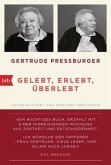In the closing weeks of World War II, advancing Allied armies uncovered the horror of the Nazi concentration camps. The first camp to be liberated in western Germany was Buchenwald, on April 11, 1945. Within days, a special team of German-speaking intelligence officers from the U.S. Army was dispatched to Buchenwald to interview the prisoners there. In the short time available to them before the inmates' final release from the camp, this team was to prepare a report to be used against the Nazis in future war crimes trials. Nowhere else was such a systematic effort made to talk with prisoners and record their firsthand knowledge of the daily life, structure, and functioning of a concentration camp. The result was an important and unique document, The Buchenwald Report. Shockingly, not long after the war ended The Buchenwald Report was almost lost forever. Only selected portions were entered as evidence at the Nuremberg trials. Professor Eugen Kogon, a prisoner at Buchenwald who assisted the Army specialists in conducting their interviews and writing the report, made use of the material gathered as a background source for his classic book, The Theory and Practice of Hell, but subsequently his copy was accidently destroyed. Thus the complete report was never published, and both the original document and a precious handful of copies gradually disappeared. Recently - more than four decades later - a single, faded carbon copy was discovered, apparently the only one still in existence. It is translated from German and presented here in book form, as its authors intended, for the first time.
Bitte wählen Sie Ihr Anliegen aus.
Rechnungen
Retourenschein anfordern
Bestellstatus
Storno








